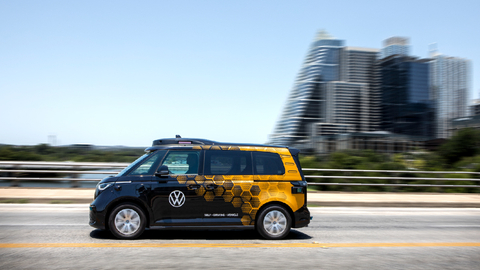Volkswagen ADMT Announces Agreement With Mobileye for Autonomous Driving
- Volkswagen is the first vehicle manufacturer to develop an autonomous Level 4 service vehicle for large-scale production
-
The aim is to use it in the commercial sector, for example for mobility and transport services in
Europe and theUSA - High synergies with systems for automated driving within Volkswagen Group: shared module use from Level 2+ to Level 4

The Volkswagen ID. Buzz AV built on the Mobileye Drive™ autonomous platform. (Photo: Mobileye)
The main part of the agreement covers delivery and use of a self-driving system (SDS) for a special version of the ID. Buzz, which has been under development for autonomous driving since 2021. It corresponds to the so- called Level 4 definition of the Society of Automotive Engineers (SAE), in which the autonomous vehicle operates self-driving in a defined area such as a city. The basis for this are various software and hardware components, including two independent high-performance computers as well as 13 cameras, nine lidar and five radar units, each of which is capable of producing 360-degree surroundings. A constant online connection to clouds provides the autonomous vehicles with swarm data from other road users about the traffic situation as well as updates to the three-dimensional maps.
“Bringing autonomous shuttles on the road in large quantities requires cooperation from strong partners,” says Christian Senger, member of the Board of Management at Volkswagen Commercial Vehicles, responsible for Autonomous Driving: “We are developing the first fully autonomous large- scale production vehicle, and Mobileye brings its digital driver on board.”
An advantage of the cooperation is the synergy with systems for automated driving in the Volkswagen group; depending on the expansion level, modules can be shared across SAE levels from 2+ to 4. The aim of Volkswagen ADMT GmbH is to develop the fully electric autonomous ID. Buzz AD for the use in mobility and transport services from 2026.
This also includes intelligent fleet control: The Volkswagen Group company MOIA has been operating
Autonomous vehicles for mobility and transportation services solve the driver shortage that has been the case for many years. Robo-shuttles promote both the quality of life and the economic development of cities.
Volkswagen Commercial Vehicles: We Transport Success, Freedom and Future As a leading manufacturer of light commercial vehicles, the Volkswagen Commercial Vehicles brand (VWCV) is reshaping the transportation of goods, services and people in a fundamental and lasting way. Our vehicles transport construction workers, families and adventurers, bread rolls, parcels and surfboards. Every day they help countless people all over the world to do a good job, they operate as mobile workshops and they bring paramedics and police personnel to wherever they are needed. At our sites in
About Mobileye
Mobileye (Nasdaq: MBLY) leads the evolution of mobility with its autonomous driving and driver-assistance technologies, based on world-renowned expertise in artificial intelligence, computer vision, mapping, and integrated hardware and software. Since its founding in 1999, Mobileye has enabled the wide adoption of advanced driver-assistance systems while pioneering groundbreaking technologies such as REM™ crowdsourced mapping, True Redundancy™ sensing, Responsibility-Sensitive Safety™ (RSS™) driving policy and Driving Experience Platform (DXP). These technologies support a product portfolio structured for scale and designed to unlock the full potential of mobility, offering a range of solutions from premium ADAS to autonomous vehicles. By the end of 2023, about 170 million vehicles worldwide had been equipped with Mobileye technology. In 2022, Mobileye listed as an independent company separate from Intel (Nasdaq: INTC), which retains majority ownership. For more information, visit https://www.mobileye.com.
View source version on businesswire.com: https://www.businesswire.com/news/home/20240320135121/en/
Mobileye
Justin Hyde
Director, Corporate Communications
+1 (202) 656-6749
justin.hyde@mobileye.com
Source: Mobileye







